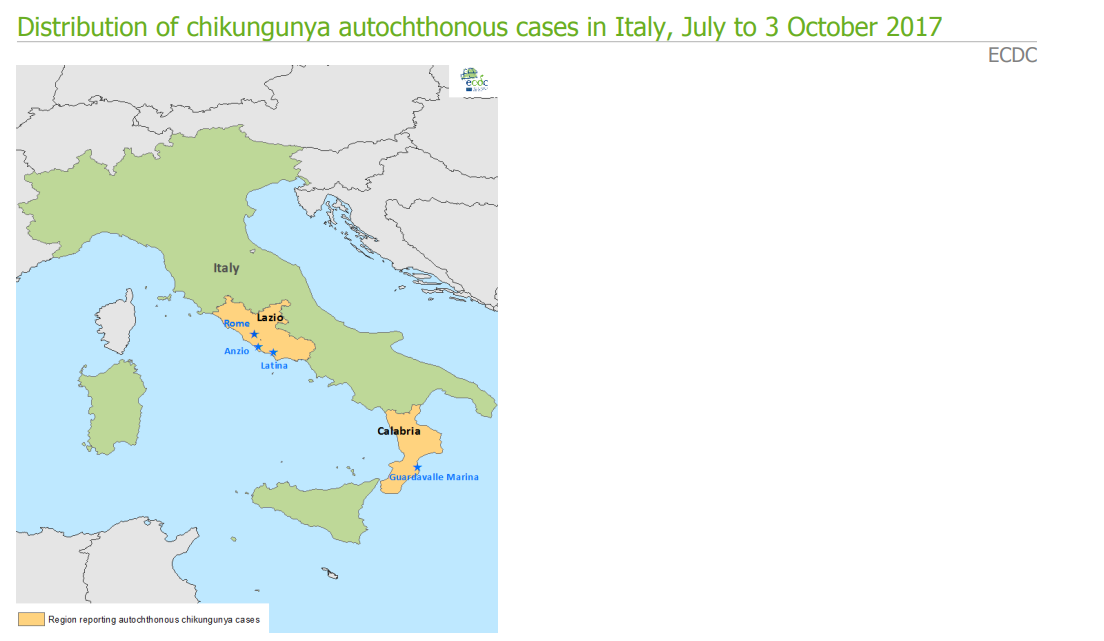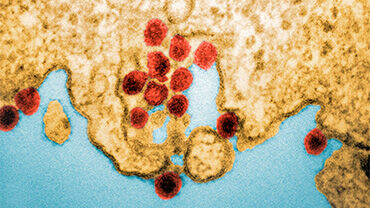Epidemiological update: Chikungunya – Europe - 2017
Since August 2017, France and Italy have reported autochthonous transmission of chikungunya virus, respectively in the Var department, France and the Lazio and Calabria regions, Italy. The two events involve strains of different origin and are therefore not related.

Weekly update
As of 4 October, Italy reported 239 chikungunya cases in the Lazio region (146 confirmed and 93 probable) and six autochthonous confirmed cases in the city of Guardavalle, Calabria region. Furthermore, three confirmed cases were reported in Emilia-Romagna (1), Marche (1) and France (1) and one probable case was reported in Germany. Three confirmed cases had an epidemiological link to the Anzio region, and one probable case in Rome. Furthermore, four confirmed cases with a history of travel to Guardavalle marina were notified from Lazio (1) and Emilia-Romagna region (3). As of 4 October 2017, Calabria region reported 55 chikungunya cases in Guardavalle. This brings the number of reported cases in Italy to 298 cases. Since the previous CDTR, France has reported six new chikungunya cases. As of 3 October, authorities had reported 17 autochthonous cases in Var department: 13 confirmed cases, three probable cases and a suspected case with compatible symptoms that is under investigation.
Epidemiological summary
The two events described below in France and in Italy are two distinct events. There is epidemiological and microbiological evidence highlighting the fact that the clusters in France and in Italy are not related.
On 11 August 2017, France reported through the EWRS an outbreak of autochthonous chikungunya cases in the Var department, southern France. As of 3 October, France reports two clusters. The first cluster, in Cannet-des-Maures, includes eleven cases (eight confirmed, two probable and one suspected). The second cluster, in Taradeau includes five confirmed cases and one probable case. Taradeau commune is 13 kilometres away from Cannet-des-Maures. There is an epidemiological link between the cases in Taradeau and Cannet-des-Maures, indicating that the two clusters are related. As stated in the Eurosurveillance article 'Preliminary report of an autochthonous chikungunya outbreak in France, July to September 2017' published 28 September 2017, the virus circulating in France belongs to an East Central South African (ECSA) sub-lineage that includes isolates from the Central African region (e.g. Gabon, Republic of Congo). The virus isolated from the index patient is carrying the E1-A226V mutation. Full genome analysis is ongoing and the sequence will be submitted to GenBank.
As of 4 October, Italy had reported 239 chikungunya cases in the Lazio region (146 confirmed and 93 probable) and six autochthonous confirmed cases in the city of Guardavalle, Calabria region. Furthermore, three confirmed cases were reported in Emilia-Romagna (1), Marche (1) and France (1) and one probable case was reported in Germany. Three confirmed cases had an epidemiological link to the Anzio region, and one probable case in Rome. Furthermore, four confirmed cases with a history of travel to Guardavalle marina were notified from Lazio (1) and Emilia-Romagna region (3). As of 4 October 2017, Calabria region had reported 55 chikungunya cases in Guardavalle. As stated in the Eurosurveillance article 'Detection of a chikungunya outbreak in Central Italy, August to September 2017' published 28 September, the virus circulating in Italy belongs to the East Central South African (ECSA) lineage and show 100% similarity to a strain involved in an ongoing epidemic in Pakistan. The virus isolated does not carry the E1-A226V mutation. The outbreak sequence is available in GenBank.
Sources: Lazio Region | MoH Italy | ISS | France ARS PACA | France ARS PACA
ECDC assessment
The two outbreaks in France and Italy are unrelated and result from separate introductions of the virus, probably from Africa and Asia, respectively. Having concurrent, distinct outbreaks of chikungunya in France and Italy highlights that the environmental conditions in 2017 are favourable for the local transmission of introduced chikungunya virus strains. In France, response measures, including vector control, have been implemented. The fact that the strain harbours the E1-A226V mutation may explain the relatively larger number of autochthonous cases observed this year compared to the 2010 outbreak in the same region (i.e. two cases reported in 2010). The conclusions of the latest ECDC rapid risk assessment published on 24 August 2017 on the 'Cluster of autochthonous chikungunya cases in France' remain valid. In Italy, this is the first known transmission of chikungunya in central and southern Italy and therefore, in the absence of herd immunity, most of the inhabitants should be considered as susceptible to chikungunya virus disease. The likelihood of further spread within Italy is still moderate with suitable but less favourable conditions for vector activity in the coming weeks. In the areas already affected more cases can be expected to be identified in the near future. There is a low likelihood of introduction of the virus and subsequent local transmission in other EU countries where Aedes albopictus is present and active.
Actions
ECDC has published a rapid risk assessment on the cluster of autochthonous chikungunya cases in France on 24 August 2017 and a rapid risk assessment on the clusters of autochthonous chikungunya cases in Italy on 14 September 2017. ECDC is updating the rapid risk assessment on chikungunya in Italy.







